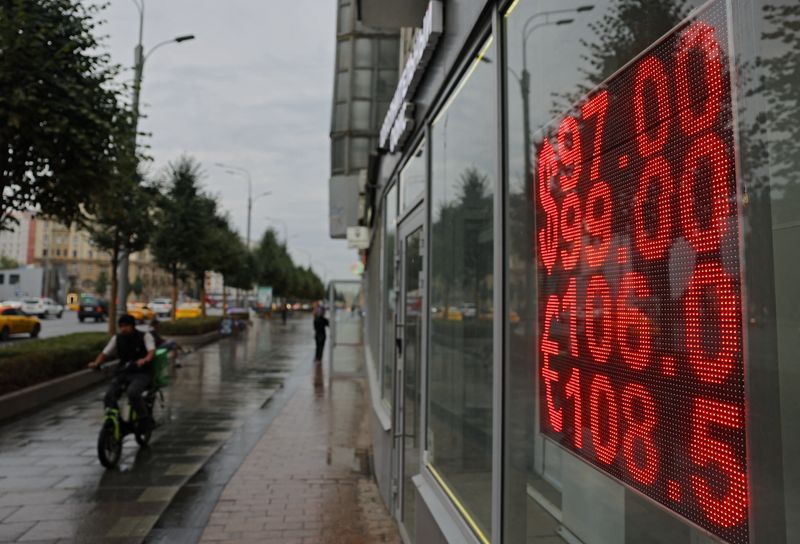Russian stocks retreat from pre-invasion high as rouble rebounds
2023.08.14 12:01

© Reuters. FILE PHOTO: A board showing currency exchange rates of the U.S. dollar and euro against Russian rouble is on display in a street in Moscow, Russia, August 12, 2023. REUTERS/Evgenia Novozhenina/File Photo
By Alexander Marrow
(Reuters) – Russia’s benchmark stock index retreated on Monday from its highest since before Moscow sent troops into Ukraine on Feb. 24, 2022, after the central bank suddenly announced an emergency policy meeting on Tuesday, ending a sharp slide in the rouble.
President Vladimir Putin’s economic adviser blamed the central bank’s “soft monetary policy” for the weakness of the currency, which has come under heavy pressure from Russia’s shrinking current account surplus and demand for foreign currency outstripping supply.
But after slumping to its weakest in almost 17 months past 101 per dollar, the rouble pared all intraday losses to strengthen after the central bank announced an extraordinary policy meeting, to be held on Tuesday, raising expectations for a hike in borrowing costs.
The bank last raised its key rate by 100 basis points to 8.5% on July 21.
“Another significant increase in the key rate is likely,” said BCS World of Investments in a note.
By 1510 GMT, the rouble was 1% stronger against the dollar at 98.45 , firming back below the 100 threshold.
It gained 1.4% to trade at 107.23 versus the euro and firmed 1.8% against the yuan to 13.45 , also paring intraday losses against both.
Sweeping volatility has become the norm for Russian assets. Stocks on Monday briefly hit their highest since before Moscow launched what it calls a “special military operation” in Ukraine, before falling back.
The rouble-based MOEX Russian index was 0.1% higher at 3,157.1 points.
“The unstoppable and puzzling growth of the rate… continues to support retail investors’ interest in equities as a way to save their depreciating rouble savings,” said Sinara Investment Bank in a note.
The dollar-denominated RTS index was up 0.7% to 1,008.3 points.
“Geopolitical risk has gone into the background,” said Yulia Goldina, senior analyst at BCS. “It seems we have got used to living in these circumstances.
“The main reason for the (MOEX index’s) growth is the weakening of the rouble,” Goldina said. “After all, the share of exporters in the rouble index is about 60%.”
, a global benchmark for Russia’s main export, was down 0.7% at $86.24 a barrel, not far from a more than seven-month high hit last week, but the rouble has struggled to benefit.
A trader at a large Russian bank told Reuters the market was confused: “Everyone is ready for the inflow of revenues from expensive oil, but it seems to be hanging somewhere, and our regulators are somehow indifferent, there is nothing to rely on.”








